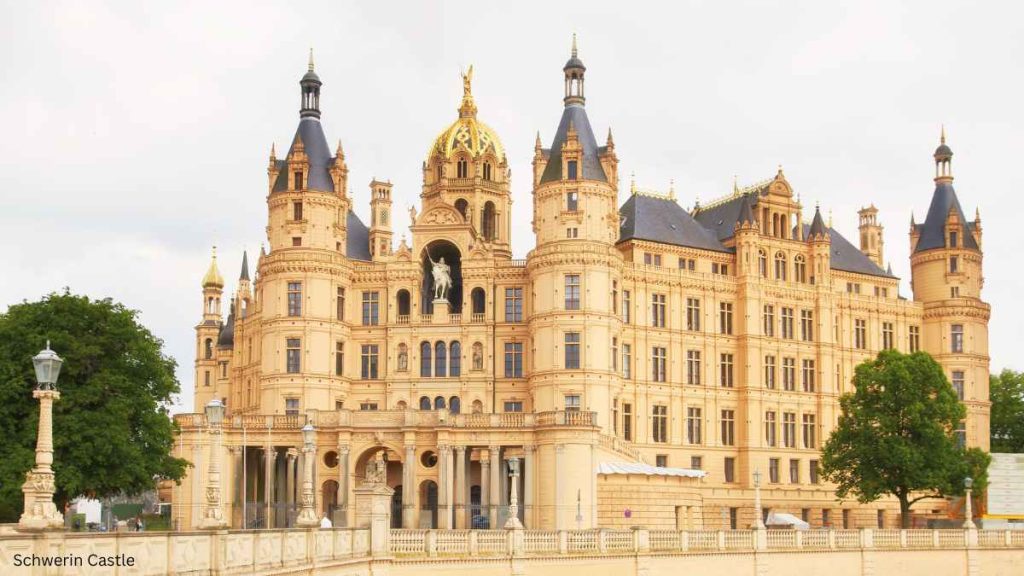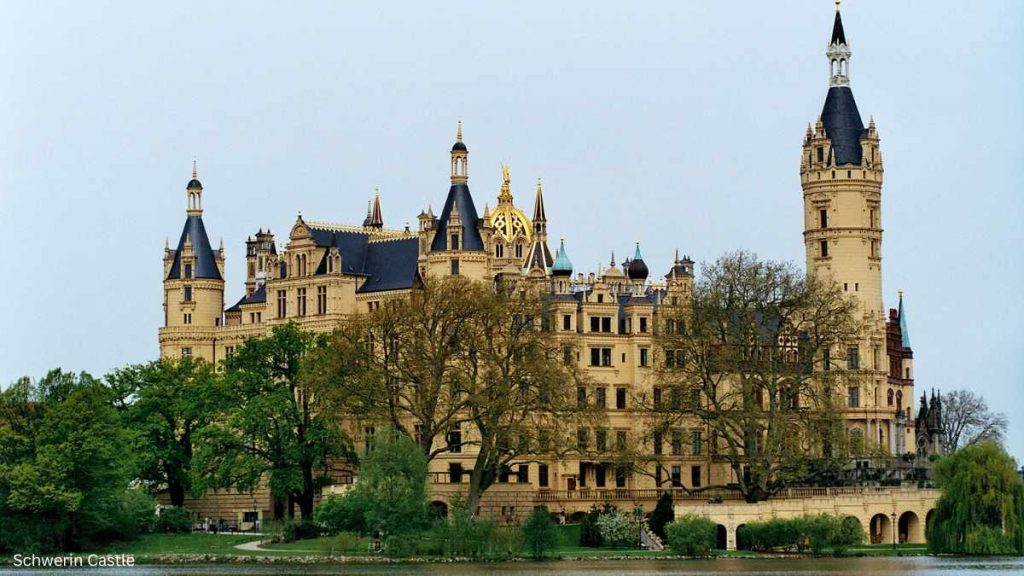The Schwerin Castle, nestled in the charming city of Schwerin, Germany, stands as a testament to centuries of rich history and architectural brilliance. With its awe-inspiring presence and picturesque location on an island in Lake Schwerin, the castle is an iconic landmark that captivates visitors from near and far. This introduction aims to provide a glimpse into the magnificence and significance of Schwerin Castle.
A. Brief overview of Schwerin Castle
Dating back to the 10th century, Schwerin Castle has undergone numerous transformations, each contributing to its current grandeur. Originally a fortification built to protect the city, the castle gradually evolved into a palatial residence for the dukes and grand dukes of Mecklenburg. With its stunning blend of architectural styles, including Gothic, Renaissance, and Baroque, the castle showcases the artistic prowess of various eras.
B. Significance of Schwerin Castle
Schwerin Castle holds immense historical and cultural significance. It served as the seat of power for the Mecklenburg duchy and later the grand duchy. The castle not only symbolized the authority and wealth of its ruling families but also witnessed pivotal events in the region’s history. From political negotiations to royal celebrations, the castle’s halls have borne witness to countless important moments.
Moreover, Schwerin Castle is an architectural masterpiece. Its striking towers, ornate facades, and picturesque gardens create a captivating ensemble that reflects the opulence and taste of the ruling elites. The interior of the castle is equally impressive, with lavishly decorated rooms adorned with intricate frescoes, exquisite furniture, and valuable artworks.
Today, Schwerin Castle stands as a prominent cultural heritage site and a major tourist attraction. Its historical and architectural significance have earned it recognition as one of the most important castles in Germany. Visitors can explore the castle’s opulent chambers, stroll through its beautifully landscaped gardens, and immerse themselves in the rich tapestry of Mecklenburg’s past.
In the following sections, we will delve deeper into the history, architecture, notable features, and cultural significance of Schwerin Castle, offering a comprehensive exploration of this enchanting destination.
Table of Contents
History of Schwerin Castle
A. Origins and Early History of Schwerin Castle
The origins of Schwerin Castle can be traced back to the 10th century when a fortification was established on the site to protect the city of Schwerin from potential invaders. Over time, this initial fortification grew in size and importance. The earliest known record of a castle on the island dates back to the year 1160. It served as a strategic stronghold for the Obotrite Prince Niklot, who defended the area against German forces.
B. Construction and Architectural Features
The construction of Schwerin Castle spanned several centuries and witnessed the influence of various architectural styles. The castle underwent major transformations under the rule of the Mecklenburg dukes and grand dukes.
The most significant construction phase took place during the Renaissance era in the mid-16th century. Duke Johann Albrecht I commissioned the renowned Dutch architect Philipp Brandin to expand and remodel the castle. Brandin’s design incorporated elements of the Renaissance style, featuring symmetrical facades, ornate sculptures, and decorative elements such as pilasters and friezes.
In the following centuries, additional modifications were made to the castle. Notable additions include the grand staircase and the bridge connecting the island to the mainland, both constructed during the 19th century in a Neo-Renaissance style. The castle’s architecture also displays Gothic influences, particularly in the tower structures, with their pointed arches and spires.
C. Role and Significance in the Region’s History
Schwerin Castle played a crucial role as the residence and seat of power for the Mecklenburg dukes and grand dukes. It was a symbol of their authority, wealth, and prestige. The castle served as the administrative and political center of the Mecklenburg region, witnessing important events and hosting notable figures throughout history.
During the Thirty Years’ War in the 17th century, Schwerin Castle suffered significant damage. However, it was later restored and became a focal point for the cultural and intellectual life of the grand duchy. The grand dukes played a pivotal role in supporting the arts and sciences, and the castle became a center for cultural patronage.
The castle’s significance extended beyond its political and administrative roles. It served as a venue for royal celebrations, diplomatic negotiations, and extravagant festivities. It was a place where alliances were formed, treaties were signed, and the ruling elite showcased their wealth and refinement.
In the 20th century, Schwerin Castle faced challenges as it underwent various changes in ownership and function. Following the end of the monarchy, the castle served briefly as a museum and later as a school. However, during the Second World War, the castle suffered heavy damage due to bombings.
Despite the destruction, extensive restoration efforts were undertaken in the post-war period to return the castle to its former glory. Today, Schwerin Castle stands as a testament to the region’s history, attracting visitors from around the world who come to admire its architectural beauty and immerse themselves in the rich heritage of Mecklenburg.
In the next sections, we will explore the layout, architectural features, and notable artworks of Schwerin Castle, providing a closer look at the splendor and cultural significance of this magnificent structure.
Layout and Architecture
A. Exterior Design and Appearance
Schwerin Castle presents a mesmerizing sight with its enchanting exterior design. Situated on an island in Lake Schwerin, the castle showcases a harmonious blend of architectural styles spanning several centuries. Its prominent feature is the central tower, known as the “Donjon,” which rises majestically above the surrounding structures. With its pointed spire, intricate details, and commanding presence, the Donjon is a defining element of the castle’s silhouette.
The castle’s exterior facades exhibit a combination of Renaissance and Gothic influences. Elaborate sculptures, including allegorical figures, adorn the facades, adding a touch of artistic flair. The facade facing the lake boasts an impressive balcony supported by decorative corbels, providing a picturesque vantage point and enhancing the castle’s aesthetic appeal.
B. Interior Layout and Notable Rooms
The interior of Schwerin Castle is no less captivating than its exterior. It encompasses a series of lavishly decorated rooms that offer a glimpse into the opulent lifestyle of the ruling elite. From ceremonial halls to private chambers, each space reflects the intricate craftsmanship and artistic sensibilities of its respective era.
One of the notable rooms is the Grand Duke’s Audience Hall, adorned with elaborate stuccowork, gilded ornaments, and ceiling frescoes depicting historical and mythological scenes. The Throne Room, with its grand chandeliers, imposing fireplace, and rich tapestries, exudes regal splendor. The castle also houses a remarkable collection of historical furniture, including luxurious beds, cabinets, and tables, showcasing the craftsmanship of the period.
The Chapel within the castle is a place of tranquility and spiritual significance. Its interior features delicate stained glass windows, intricately carved wooden pews, and a magnificent altar. The Chapel serves as a reminder of the castle’s connection to religion and the spiritual lives of its inhabitants.
C. Architectural Styles and Influences
Schwerin Castle’s architecture is a testament to the evolution of styles and influences over the centuries. The castle’s earliest foundations exhibit Romanesque and Gothic elements, seen in the lower parts of the towers and defensive walls. During the Renaissance period, the castle underwent extensive remodeling, incorporating symmetrical designs, decorative motifs, and a focus on proportion and harmony.
In addition to Renaissance influences, the castle also showcases Gothic architectural elements. The pointed arches, ribbed vaults, and slender towers exemplify the Gothic style, lending an air of romanticism and timelessness to the structure. The blend of these architectural styles creates a unique and visually striking ensemble that sets Schwerin Castle apart.
Throughout its history, the castle underwent various renovations and additions, reflecting the prevailing architectural trends of each era. The 19th-century renovations introduced Neo-Renaissance elements, such as the grand staircase and the bridge connecting the castle to the mainland. These additions contribute to the castle’s overall architectural charm and provide insights into the changing tastes and preferences of the time.
The architectural splendor of Schwerin Castle extends beyond its walls to encompass the surrounding gardens and landscape. The castle’s location on an island in Lake Schwerin allows for breathtaking views and a serene atmosphere. The meticulously maintained gardens, with their manicured lawns, colorful flowerbeds, and tranquil water features, provide a picturesque setting that complements the castle’s beauty.
In the following sections, we will explore the notable features and artworks within Schwerin Castle, shedding light on the treasures that lie within its magnificent walls.

Notable Features and Artworks
A. Castle Towers and Defensive Structures
Schwerin Castle boasts several towers that contribute to its architectural splendor and served defensive purposes in its early history. The most prominent tower is the aforementioned Donjon, rising high above the castle. Its strategic location and commanding height provided a vantage point for surveillance and defense. Other towers, such as the Lantern Tower and the Knight’s House Tower, add to the castle’s impressive skyline.
The defensive structures surrounding the castle include bastions and ramparts. These fortifications, built during the Renaissance era, were designed to protect the castle from potential attacks. They showcase the military importance of the castle and reflect the historical context in which it was constructed.
B. Gardens and Surrounding Landscape
The gardens surrounding Schwerin Castle add to its charm and offer a serene retreat for visitors. The castle’s island location in Lake Schwerin provides a picturesque setting, with the tranquil waters and lush greenery creating a harmonious backdrop for the castle’s grandeur.
The castle gardens are meticulously landscaped and feature manicured lawns, colorful flowerbeds, and enchanting water features. Strolling through the gardens, visitors can admire the symmetry and beauty of the landscape, which mirrors the castle’s architectural aesthetics. The gardens provide an opportunity to appreciate the natural elements that complement the castle’s grand design.
C. Notable Artworks and Collections within the Castle
Schwerin Castle houses a remarkable collection of artworks and historical artifacts that provide insight into the cultural and artistic heritage of the region. The castle’s interior is adorned with valuable paintings, sculptures, tapestries, and decorative arts, showcasing the artistic endeavors of different periods.
One notable artwork within the castle is the altarpiece in the Chapel. Created by the renowned German sculptor Ernst Barlach, the altarpiece depicts scenes from the life of Jesus Christ in a modern expressionist style. Its emotional intensity and powerful symbolism make it a significant artistic treasure within the castle.
The castle’s collections also include exquisite furniture, porcelain, and silverware, reflecting the opulence and refinement of the ruling elite. Visitors can marvel at the intricate craftsmanship and the historical significance of these items, gaining a deeper understanding of the cultural heritage associated with Schwerin Castle.
In addition to the permanent collections, the castle occasionally hosts temporary exhibitions, showcasing various art forms and exploring different themes. These exhibitions provide an opportunity for visitors to engage with contemporary art and cultural expressions within the historical setting of the castle.
As we continue our exploration of Schwerin Castle, the next sections will focus on the historical events, transformations, and cultural significance of this architectural gem, shedding light on its enduring legacy.
Historical Events and Transformations
A. Changes and Expansions Throughout History
Schwerin Castle has undergone various changes and expansions throughout its long history. From its origins as a fortification in the 10th century, the castle gradually evolved into a grand residence for the ruling dukes and grand dukes of Mecklenburg. Each generation of rulers left their mark on the castle, resulting in its current architectural splendor.
One of the significant transformations occurred during the Renaissance era in the 16th century. Duke Johann Albrecht I commissioned the expansion and remodeling of the castle, incorporating Renaissance architectural elements and expanding the living quarters. This period of renovation added to the grandeur of the castle, elevating it to a magnificent palatial residence.
B. Schwerin Castle During Different Eras and Rulers
Schwerin Castle played a central role in the lives of the Mecklenburg dukes and grand dukes throughout different eras. As the seat of power, the castle witnessed the reigns of various rulers, each leaving their own imprint on the structure.
During the 19th century, under the rule of Grand Duke Friedrich Franz II, further changes were made to the castle. The grand duke, influenced by the architectural trends of the time, initiated the construction of the grand staircase and the bridge connecting the island to the mainland. These additions incorporated Neo-Renaissance elements, enriching the castle’s aesthetic appeal.
C. Restorations and Preservation Efforts
Schwerin Castle, like many historical structures, faced periods of neglect and damage over time. However, significant restoration efforts have been undertaken to preserve and revive the castle’s original splendor.
After the Second World War, the castle suffered extensive damage due to bombings. However, dedicated restoration work commenced in the post-war years to repair and reconstruct the damaged areas. The restoration process involved meticulous research and attention to detail, aiming to recapture the castle’s historical authenticity.
Today, Schwerin Castle stands as a testament to the preservation and restoration efforts. It has been carefully maintained to ensure its architectural integrity and historical significance. The castle serves as a cultural heritage site and a museum, allowing visitors to immerse themselves in the rich history and architectural grandeur of the region.
The ongoing preservation and conservation efforts continue to safeguard Schwerin Castle for future generations, ensuring that its beauty and historical legacy endure.
In the upcoming sections, we will explore the cultural significance of Schwerin Castle, its impact on the local community, and the experiences that await visitors who venture into this remarkable architectural gem.
Cultural Significance and Tourism
A. Schwerin Castle as a Cultural Landmark
Schwerin Castle holds immense cultural significance as a landmark representing the rich heritage of the Mecklenburg region. Its architectural magnificence, historical importance, and artistic treasures make it a symbol of cultural pride. The castle serves as a focal point for local identity, evoking a sense of belonging and connection to the region’s past.
As a cultural landmark, Schwerin Castle attracts visitors from around the world who come to appreciate its beauty and immerse themselves in its historical and artistic ambiance. The castle’s grandeur and architectural excellence make it a source of inspiration for artists, writers, and filmmakers, who often depict it as a quintessential fairytale castle.
B. Visitor Attractions and Activities
Schwerin Castle offers a wide range of attractions and activities for visitors to enjoy. Guided tours provide insights into the castle’s history, architecture, and notable artworks. Visitors can explore the opulent halls, chambers, and gardens, marveling at the exquisite craftsmanship and historical artifacts on display.
The castle also houses a museum that presents a comprehensive overview of the region’s history, providing a deeper understanding of the castle’s role in the local context. The museum showcases a diverse collection of artifacts, including paintings, sculptures, furniture, and decorative arts, giving visitors a glimpse into the cultural heritage of Mecklenburg.
In addition to the castle itself, the surrounding area offers recreational opportunities. Visitors can take leisurely walks through the picturesque gardens, enjoy boat rides on Lake Schwerin, or simply soak in the tranquil atmosphere. The castle’s island location provides a serene escape from the bustling city, allowing visitors to immerse themselves in nature while experiencing the grandeur of the castle.
C. Events and Festivals Held at the Castle
Schwerin Castle serves as a venue for various events and festivals throughout the year, further enriching its cultural significance. Concerts, theater performances, and art exhibitions take place within the castle’s walls, providing a platform for local and international artists to showcase their talents.
The castle’s stunning backdrop and historical ambiance make it an ideal setting for special events and celebrations. Festivals such as the Schwerin Castle Festival and the Castle Christmas Market attract visitors with their lively atmosphere, music, food, and cultural performances. These events offer a unique opportunity to experience the castle in a festive and vibrant setting.
The cultural events and festivals held at Schwerin Castle not only contribute to the local arts scene but also draw tourists, boosting the region’s tourism industry. They create a sense of community engagement, fostering a deeper connection between the castle, the local population, and visitors from far and wide.
Schwerin Castle’s cultural significance, combined with its tourism offerings, ensures that it remains a cherished destination for both locals and tourists, preserving its legacy as a captivating historical and artistic gem.
In the subsequent sections, we will delve into practical information for visitors, including accessibility, visitor amenities, and the overall experience of exploring Schwerin Castle.
Interesting Facts and Legends
A. Unique or Lesser-Known Facts about Schwerin Castle
Schwerin Castle is steeped in history and holds several unique and lesser-known facts that add to its intrigue:
1. Island Location: Schwerin Castle is situated on an island in Lake Schwerin, making it one of the few castles in Europe built on an island. This island setting enhances the castle’s picturesque appearance and adds to its allure.
2. Film Location: The castle has served as a backdrop for numerous films and TV shows. Its fairy tale-like architecture and scenic surroundings have attracted filmmakers, making it a popular choice for creating a magical setting on screen.
3. Clock with No Hands: The castle’s clock tower is distinctive for its lack of hands on the clock face. The story behind this unique feature is that the Grand Duke wanted to avoid the burden of keeping track of time and instead relied on the chiming of the bells to indicate the hours.
4. Historic Library: The castle houses a remarkable library with a collection of over 20,000 books, including rare manuscripts and valuable editions. The library holds books dating back several centuries and offers insights into the intellectual pursuits of the ruling elite.
B. Legends and Stories Associated with the Castle
Like many historical landmarks, Schwerin Castle is enveloped in legends and stories passed down through generations:
1. The Golden Stag: According to local legend, a golden stag is said to appear on the shores of Lake Schwerin during times of significant events or transitions. The sighting of the golden stag is believed to bring good fortune and prosperity.
2. The Ghost of Petermännchen: Petermännchen, a mischievous dwarf-like creature, is said to haunt the castle. Legend has it that he would play pranks on the castle’s residents and staff. Although not seen in recent times, the tales of Petermännchen continue to intrigue visitors.
3. The Ghost Bride: Another haunting legend associated with Schwerin Castle is that of a ghostly bride. It is said that the spirit of a young bride, who died on her wedding day, wanders the halls of the castle in her wedding gown. Her presence is believed to bring both sorrow and a sense of mystery.
These legends and stories add an air of mystique to Schwerin Castle, capturing the imagination of visitors and adding to its allure as a place of historical significance and intrigue.
In the following sections, we will provide practical information for visitors, including accessibility, visitor amenities, and tips for making the most of a visit to Schwerin Castle.

Conclusion
A. Summary of Schwerin Castle’s Historical and Cultural Importance
Schwerin Castle stands as a testament to the rich history and cultural heritage of the Mecklenburg region in Germany. From its origins as a fortification to its evolution into a grand palace, the castle has witnessed centuries of transformations and played a significant role in the region’s history.
The castle’s architectural brilliance, with its towers, defensive structures, and stunning gardens, showcases the skill and craftsmanship of different eras. Its interior layout, notable rooms, and extensive collections of artworks and historical artifacts provide a glimpse into the opulence and refinement of the ruling elite.
Schwerin Castle’s cultural significance extends beyond its architectural grandeur. It serves as a cultural landmark, evoking a sense of pride and identity for the local community. The castle attracts visitors from around the world, who are captivated by its beauty and immerse themselves in its historical and artistic ambiance.
B. Final Thoughts on Its Enduring Legacy
Schwerin Castle’s enduring legacy lies in its ability to transport visitors to a bygone era, where history, art, and architectural splendor converge. Its significance as a symbol of cultural pride and historical heritage continues to inspire awe and admiration.
Through preservation and restoration efforts, the castle has been safeguarded for future generations to appreciate and enjoy. It serves as a beacon of the past, reminding us of the rich cultural tapestry that shapes our present.
As visitors explore the castle’s halls, gardens, and collections, they not only witness the grandeur of the past but also connect with the stories, legends, and legends that surround this remarkable architectural gem.
Schwerin Castle is more than just a tourist attraction; it is a living testament to the region’s identity and a gateway to the historical and cultural legacy of Mecklenburg. Its beauty, history, and artistic treasures continue to captivate the hearts and minds of all who visit.
Whether exploring the castle’s architectural marvels, strolling through the enchanting gardens, or delving into the captivating stories and legends, a visit to Schwerin Castle is an immersive experience that leaves a lasting impression.
In conclusion, Schwerin Castle stands tall as a beacon of history, art, and cultural heritage, inviting visitors to step back in time and immerse themselves in the grandeur of centuries past. Its enduring legacy will continue to inspire and captivate generations to come, preserving the essence of Mecklenburg’s rich history and cultural identity.
You May Also Like:
Pattoo Castle: A Perfect Wedding Venue




Leave a Reply